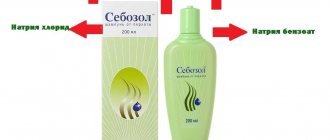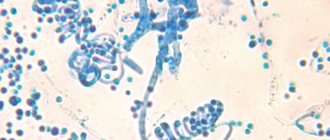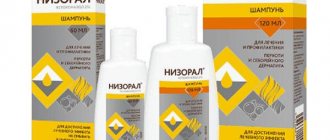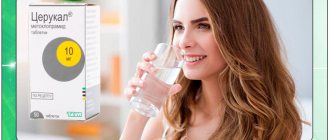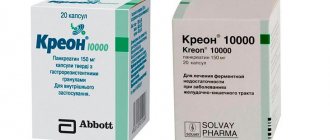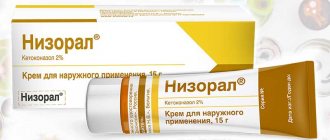Human skin is home to many pathogenic microorganisms, in particular the yeast-like fungus Malassezia furfur. Weakening of the immune system, chronic diseases and disturbances of internal processes in the body can provoke their increased reproduction. Such changes cause itching, active flaking of the scalp and the appearance of dandruff in the hair, and the disease itself is called seborrheic dermatitis. Nizoral shampoo is a medicinal product designed to suppress the activity of yeast. It will quickly and without harm eliminate the cause of dandruff, alleviate the symptoms of the disease and speed up recovery. The high cost of the drug sometimes stops patients: how justified these expenses are, we will try to figure it out further.
Compound
The main active substance of the drug is ketoconazole. Each tablet contains 200 mg of this component. Ketoconazole is an antifungal agent that comes in the form of a white, odorless powder.
This substance is active against yeast-like fungi of the genus Candida. It is also active against dermatophytes, molds, and pathogens of systemic mycoses. The product is much less active against sporothrix and mucor fungi.
Ketoconazole provides a pronounced antifungal effect, due to which recovery occurs faster.
Ketoconazole is well absorbed internally, especially in the acidic environment of the stomach.
The following substances act as excipients in tablets:
- magnesium stearate;
- lactose monohydrate;
- corn starch;
- cellulose.
Nizoral price
The drug is sold online or in standard pharmacies. The cost depends on the release form and quantity/volume in the package. Approximate prices are listed below:
| Type of medicine | Price in online stores, rubles | Price in pharmacies, rubles |
| Cream 2% tube 15 ml | 497 | 510 |
| Shampoo 2% bottle 60 ml | 743 | 780 |
| Shampoo 2% bottle 120 ml | 999 | 1100 |
| Tablets 200 mg 30 pcs. Belgium | 1727 | 1800 |
Pharmacotherapeutic group
Nizoral is a systemic antifungal agent. Its active ingredient inhibits the synthesis of ergosterol in the mycelium cells of pathogenic fungi. As a result, membrane components are disrupted, which ultimately causes the cessation of development and death of pathogenic fungi.
After the Nizoral tablet has been taken, the active substance is rapidly absorbed. Ketoconazole is distributed in equal quantities throughout the body. The drug reaches the structures of the central nervous system in small quantities.
The main active ingredient of the drug breaks down in the liver to metabolites. Most of them are excreted along with bile.
Indications for use
Nizoral tablets are usually prescribed for the treatment of various infectious processes caused by fungal microorganisms - not only internal, but also those that appear externally, on the skin and mucous membranes. This drug is advisable to use if topical medications do not give the desired effect.
Nizoral tablets for internal use are prescribed only in cases of severe mycoses, which is associated with the high hepatotoxicity of the drug. If it is possible to use safer agents, Nizoral is not used in the treatment of mycoses.
Indications for oral administration of Nizoral tablets are:
- oral thrush, including fungal infections of the pharynx;
- inflammatory process of hair follicles provoked by fungal microorganisms;
- lichen versicolor;
- vaginal candidiasis, especially if there is a tendency to relapse;
- severe candidiasis of the skin and mucous membranes;
- skin fungus caused by dermatophytes;
- paracoccidioidosis - severe damage to the lungs, lymph nodes and mucous membranes of the nose and mouth caused by fungi;
- fungal infections of the gastrointestinal tract, including the intestines and esophagus;
- onychomycosis is a fungal infection of the nail plates.
Nizoral in tablet form is also prescribed as a prophylaxis for fungal infections after a course of chemotherapy.
For fungal meningitis, taking Nizoral tablets is not advisable, since the active substance does not penetrate the blood-brain barrier well.
Features of Nizoral shampoo
Nizoral shampoo is a medicinal antifungal agent. Available in plastic bottles of 60 and 25 ml. Each is placed in a cardboard package and has included instructions. The drug is for external use only. The consistency is quite thick, orange in color. Has a pleasant cosmetic aroma.
Possible side effects: itching, irritation, allergic reactions. But they occur very rarely. The condition of the hair may also change; it may become drier or oilier, depending on individual characteristics and the reaction of the scalp to the product.
Indications for use:
- Pityriasis versicolor
- Seborrheic eczema
- Dandruff of various origins
- Fungal skin lesions
When using the product on gray or bleached hair, a slight discoloration may occur after washing with regular shampoo.
Avoid contact with eyes as it may cause severe irritation and watery eyes. If trouble occurs, you need to rinse your eyes with plenty of water.
Dosage
When treating fungal infections with Nizoral tablets, you must follow the dosage prescribed by your specialist.
According to the instructions for this drug, it should be taken with food or immediately after eating - this will ensure better absorption of the main active ingredient.
The frequency and dose depend on the specific disease:
- For vaginal candidiasis, taking 2 tablets daily for 7 days in a row is recommended.
- For fungal infections of the skin of the body and head, as well as for systemic infections and dermatophytosis, you need to take one tablet of the product daily. If there is no improvement, then the dosage is increased to two tablets per day. For dermatophytosis, the duration of treatment will be a month. For fungal seborrhea of the head - from 6 to 8 weeks, for pityriasis versicolor - about 10 days. For systemic mycoses, therapy can last up to six months.
- When treating nail plate fungus, the course of therapy lasts quite a long time, about 4-6 months.
To prevent fungal infection, a one-time dose of tablets (400 mg) is indicated.
For children, the dosage is determined based on their body weight. So, over the age of three years with a body weight of 15-30 kg, give half a tablet once a day. If the child's weight exceeds 30 kg, then the dosage is similar to that indicated for adults.
For children whose body weight is less than 15 kg, oral administration of Nizoral is contraindicated.
Long-term drug therapy requires monitoring of adrenal function.
The duration of taking the drug depends on what type of fungal infection was identified in the patient. It varies from one week to six months. If necessary, the course of therapy can be adjusted by the attending physician; this cannot be done without permission. Much depends on the current condition of the patient and test results.
Rules of application
Using Nizoral is easy; the treatment procedure can be combined with taking a shower.
Method of use, according to the instructions from the manufacturer of the product:
- Wet your hair with water.
- Rub some of the product into your palms and distribute onto the surface of your head.
- Massage the skin with your fingertips for 2-3 minutes.
- Distribute the resulting foam over the entire length of the hair.
- 5 minutes after application, rinse off any remaining product with warm water.
Advice. If you notice unusually stiff and dry ends after washing your hair, apply natural oil or balm to them. It is not recommended to treat the entire hair and scalp.
Application frequency:
- Nizoral shampoo for pityriasis versicolor is recommended to be used daily, the duration of the treatment course is 5–7 days. To prevent the disease, one-time use every 3 days is allowed.
- For the treatment of seborrheic dermatitis, dandruff and eczema, the drug is used twice a week. The treatment course lasts up to 4 weeks. For preventive purposes, shampoo is used once a week.
If recovery is not achieved after the course, the doctor prescribes corticosteroids for a period of 2–3 weeks. These drugs and topical antifungal creams can also be used in severe stages of the disease.
Contraindications
Nizoral in tablet form has many contraindications, so it can only be taken on the recommendation of a doctor.
The medication should not be used for such conditions and diseases as:
- children under 3 years of age;
- individual intolerance;
- acute or chronic pathologies of the liver, accompanied by impaired functionality of the organ;
- the period of pregnancy and breastfeeding, since ketoconazole tends to penetrate the placenta and into breast milk (accordingly, affect the development of the fetus and child);
- Lactose intolerance or poor digestibility.
In no case should you take Nizoral tablets with alcohol, since alcoholic beverages increase the risk of side effects and also increase the toxic effect on the liver.
Nizoral tablets are prescribed with extreme caution to patients who have low stomach acidity.
Since this drug is characterized by a pronounced negative effect on the liver, it is recommended to start taking Nizoral only after the necessary tests have been carried out. In addition, during treatment, it is necessary to periodically (once every 1-1.5 months) monitor liver function using laboratory tests (blood from a vein).
Drug interactions
Clinically significant interactions with the simultaneous use of Nizoral in the form of cream or shampoo with other drugs have not been established.
Pills
Drugs that reduce gastric acidity reduce the absorption of ketoconazole taken orally.
The use of ketoconazole is not recommended with drugs that induce microsomal oxidation (such as carbamazepine, rifabutin, isoniazid, phenytoin, nevirapine, rifampicin), since they significantly reduce its bioavailability.
Ritonavir increases the bioavailability of ketoconosal, so the dose of the latter should be reduced.
Ketoconazole may inhibit the metabolism of drugs broken down by cytochrome P450 CYP3A isoenzymes, which may result in increased and/or prolongation of their effects, including side effects.
When prescribing the following drugs simultaneously, it is necessary to monitor their concentration in the blood plasma, the severity of the therapeutic effect and side effects (if necessary, the dosage of ketoconazole should be reduced):
- Some immunosuppressive drugs: tacrolimus, cyclosporine, sirolimus;
- Blockers of slow calcium channels of the dihydropyridine series, cleaved by the CYP3A4 isoenzyme, and presumably verapamil;
- Some HMG-CoA reductase inhibitors, for example, atorvastatin;
- Some anticancer drugs such as imatinib, docetaxel, busulfan, erlotinib, rose vinca alkaloids;
- Some glucocorticosteroids, such as dexamethasone, fluticasone, methylprednisolone, budesonide;
- HIV protease inhibitors such as saquinavir and indinavir;
- Indirect anticoagulants;
- Other drugs: buspirone, brotizolam, carbamazepine, alprazolam, cilostazol, alfentanil, ebastine, fentanyl, reboxetine, eletriptan, rifabutin, digoxin, repaglinide, tolterodine, solifenate, sildenafil, quetiapine, trimetrexate, midazolam for oral use.
Ketoconazole increases the concentration of sulfonylurea derivatives and increases the risk of hypoglycemia.
In case of simultaneous use of alcohol, a disulfiram-like reaction may develop, manifested by peripheral edema, headache, rash, nausea, and redness.
Side effects
The drug Nizoral has a wide range of contraindications. These should include the following:
- headache;
- stomach ache;
- nausea;
- increased sensitivity to light;
- stool disorders (diarrhea);
- erectile dysfunction in men (rare);
- constipation;
- feeling of dryness in the mouth;
- bloating;
- change in tongue color;
- dizziness;
- insomnia;
- increased nervous excitability;
- anxiety;
- fever;
- hives;
- menstrual irregularities;
- flow of blood from the nasal passages;
- baldness;
- decreased blood pressure;
- chills;
- feeling of numbness in the body;
- decrease in the number of platelets in the blood;
- arthralgia.
Severe adverse reactions associated with disorders of the immune system are also possible: anaphylactic shock, angioedema.
Overdose
If the dosage of the drug is increased without authorization, an overdose may occur. There is no specific antidote for ketoconazole.
Signs of exceeding the dose when treating with Nizoral in tablet form are:
- nausea;
- increased fatigue;
- inhibition of reactions;
- drowsiness;
- rapid weight loss for no apparent reason;
- loss of appetite;
- vomit;
- profuse sweating;
- pain in the abdomen.
If the patient has exceeded the dose, activated charcoal must be taken within the first hour after taking the tablet. The dose depends on body weight.
If necessary, gastric lavage can be performed. The patient's condition must be closely monitored.
Can Nizoral shampoo be used for children?
The instructions for Nizoral shampoo indicate a treatment regimen for children from infancy, therefore, it can be used . You just need to take precautions to protect your child from getting the product in the eyes or inside. The shampoo is not for children and does not have a “tear-free” formula.
It is also necessary to monitor the condition of the skin, as the product can cause peeling or irritation of delicate baby skin. If an allergic reaction occurs, you should immediately stop the course of treatment and give the child an antihistamine (Zodak, Suprastin).
Combination with other drugs
Absorption of the main active ingredient of the drug Nizoral in tablets is reduced while taking antacids (aluminum hydroxide).
Caution should be exercised when taking Nizoral simultaneously with drugs such as:
- Drugs that reduce the level of hydrochloric acid in gastric juice. It is better to take them 1 hour before or 2 hours after taking Nizoral tablets, and wash down Nizoral itself with some sour juice.
- Other antifungal agents (as part of combination therapy).
Taking Nizoral tablets is contraindicated while taking medications such as:
- Triazolam;
- Sertindole;
- Ergotamine;
- Levomethadyl;
- Mizolastine;
- Ranolazine;
- Everolimus;
- Ergometrine;
- Domperidone;
- Terfenadine;
- Astemizole;
- Pimozide;
- Halofantrine;
- Cisapride;
- Quinidine;
- Lovastatin;
- Disopyramide.
If there is a need to take any medications along with Nizoral, you should definitely consult a doctor to reduce the risk of developing significant undesirable effects.
Pharmacological properties
Pharmacodynamics
Ketoconazole is a synthetic derivative of imidazole dioxolane, characterized by a mycostatic or fungicidal effect against higher fungi (eumycetes), dermatophytes (Microsporum spp., Epidermophyton floccosum, Trichophyton spp.), dimorphic fungi and yeasts (Cryptococcus, Candida, Torulopsis, Malassezia). Sporothrix schenckii, Aspergillus spp., some species of Dematiaceae, Mucor spp. are less sensitive to the action of ketoconazole. and other phycomycetes, excluding Entomophthorales.
Ketoconazole slows down the biosynthesis of ergosterol in fungi and promotes changes in the composition of other lipid components in membranes. The results of clinical studies and studies of interactions with other drugs confirm that when taking Nizoral in tablet form at a dosage of 200 mg 2 times a day for 3-7 days, a slight prolongation of the QT interval was sometimes observed. The average maximum increase in the QT interval to 6-12 ms was recorded 1-4 hours after drug administration, when ketoconazole plasma levels reached peak values. However, such an increase in the QT interval is of little clinical significance.
When Nizoral is prescribed at a therapeutic dose of 200 mg 1 time per day, a transient decrease in plasma testosterone concentration may be observed. This indicator returns to its original value within 24 hours after ketoconazole enters the body. During a long course of therapy using this dosage, testosterone levels usually differ slightly from the control value.
When healthy volunteers took ketoconazole at a daily dose of 400 mg or higher, there was a decrease in the “cortisol response” to ACTH stimulation.
Nizoral shampoo helps to quickly eliminate itching and flaking, which are often symptoms of pityriasis versicolor, dandruff, and seborrheic dermatitis.
The drug in the form of a cream quickly acts on the itching associated with yeast and dermatophyte infections, and a decrease in the severity of symptoms is observed even before the first signs of recovery appear.
Pharmacokinetics
Ketoconazole is a weak dibasic compound that is absorbed and dissolved in an acidic environment. On average, its maximum plasma concentration is approximately 3.5 mcg/ml and is determined 1–2 hours after a single oral dose of 200 mg of Nizoral in tablet form with food. Maximum bioavailability of ketoconazole is ensured when combined with food.
The absorption of ketoconazole is reduced in patients with reduced gastric acidity who, for example, are taking antisecretory drugs (proton pump inhibitors, H2 receptor antagonists) or antacids (aluminum hydroxide), as well as in patients with achlorhydria caused by a certain disease. In such patients, the absorption of the active substance Nizoral when taking tablets before meals increases when the drug is combined with drinks that contain acid (for example, non-diet cola).
When pre-administered with the proton pump inhibitor omeprazole, the bioavailability of ketoconazole, taken as a single dose of 200 mg, was reduced to 17% compared to its bioavailability when taken on an empty stomach. When Nizoral is combined with acidic drinks and pre-administered omeprazole, the bioavailability of ketoconazole is 65% of its bioavailability when taken before meals without introducing concomitant medications into the body.
The degree of binding of ketoconazole to plasma proteins in vitro (mainly with the albumin fraction) is 99%. The substance is widely distributed throughout the tissues, but only a small amount penetrates into the cerebrospinal fluid.
After absorption from the gastrointestinal tract, ketoconazole participates in metabolic processes in the liver, forming inactive metabolites in large quantities. In vitro studies confirm that the CYP3A4 isoenzyme is involved in the metabolism of the drug. The main metabolic processes characteristic of ketoconazole are aromatic hydroxylation, oxidative O-dealkylation and oxidation and cleavage of the piperazine and imidazole rings. Ketoconazole is not an inducer of its own metabolism.
Ketoconazole is excreted from plasma in two phases: during the first 10 hours, the half-life is 2 hours, and subsequently – 8 hours. Approximately 13% of the dose is excreted through the kidneys, with about 2–4% unchanged. Ketoconazole is excreted primarily in bile in the gastrointestinal tract, after which approximately 57% of the dose is excreted through the intestines.
In patients with hepatic or renal failure, the pharmacokinetic parameters of ketoconazole generally differ slightly from those in healthy individuals. Clinical data regarding the pharmacokinetics of ketoconazole used in children in tablet form are limited.
After local application of Nizoral in the form of shampoo to the scalp, the concentrations of the active substance are not determined in the blood plasma, but are determined after local application of the drug to the entire body and amount to 11.2–33.3 ng/ml. The risk that such concentrations could provoke any drug interactions is minimal, but an increase in allergic reactions may occur.
After topical application of Nizoral cream to the skin, ketoconazole concentrations were not determined in the blood plasma of adult patients.
In a study involving 19 children suffering from seborrheic dermatitis, approximately 40 g of the cream was applied daily to the surface of the skin, the area of which exceeded 40% of body weight. At the same time, the concentrations of ketoconazole in the blood plasma were found in 5 children and ranged from 32 to 133 ng/ml. With repeated use of Nizoral in the form of a cream in large quantities (more than 3 g) in children, there is a certain risk of developing drug interactions (for example, inhibition of the metabolism of drugs in the metabolic processes of which enzymes of the CYP3A4 system are involved, in particular cisapride). Allergic reactions may also intensify.
Reviews
Lyudmila, 35 years old: Nizoral tablets helped me when I was already desperate to cure advanced nail fungus. A long course of treatment was effective and allowed me to completely forget about the problem.
Sergey, 30 years old: After I was unable to cure onychomycosis with ointments and creams alone, on the advice of a doctor, I introduced Nizoral tablets into the therapeutic course. The treatment, of course, is quite lengthy (I took the pills for 5 months, although my nails began to look good outwardly after 2 months), but the effect is obvious.
Miroslava, 32 years old: No matter how much you would like, external means alone cannot cure the fungus - you need to act from the inside. Timely prescription of the medicine allowed me to avoid the neglect of the problem and cure the fungus in 3 months.
Analogs
Means with an effect similar to the effect of Nizoral tablets are the following:
- Ketoconazole;
- Mikanisal;
- Orungal;
- Funginok;
- Mycozoral.
Since Nizoral tablets are currently not available in pharmacy chains, the specialist selects an analogue drug that is no less effective than the original.
Nizoral tablets are used to treat fungal diseases that are characterized by a severe course. This drug has a negative effect on the liver, so it can only be used if there are no other alternative treatment options.
special instructions
The instructions for use of Nizoral contain a paragraph with special instructions:
- Avoid getting shampoo into your eyes. If this happens, rinse them with water.
- If taking the medication coincides with treatment with corticosteroids, steroid therapy should be discontinued gradually over 2-3 weeks.
- Ketoconazole when applied topically does not affect the speed of psychomotor reactions.
- Do not throw the expired drug into the street or allow it to enter wastewater.
- The cream is not used in ophthalmology.
- Acidic drinks increase the absorption of ketoconazole due to the level of acidity.

